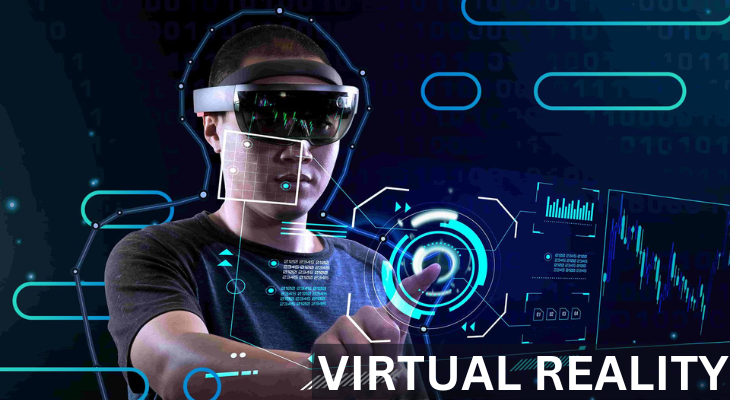Virtual Reality: Types, Applications, and More

Virtual reality, often abbreviated as VR, is a technology that has taken the world by storm, transforming the way we perceive and interact with digital environments. We shall explore the types, applications, benefits, and challenges of virtual reality in this post, delving into this fascinating field. At the conclusion of this adventure, you will possess a thorough comprehension of the virtual reality terrain.
Table of Contents
ToggleWhat is virtual reality?
Virtual reality (VR) is a technology that, when paired with a specialized headset or head-mounted display (HMD), immerses the user in a simulated reality by creating a three-dimensional, computer-generated environment. The user can utilize their sight, hearing, and occasionally touch senses to engage with this virtual world as if it were real in a virtual reality encounter.
Virtual Reality Types
Virtual reality (VR) is a rapidly evolving industry with many different kinds that provide users with unique experiences. To fully appreciate the diversity of virtual reality technology, one must comprehend these sorts. Let’s examine the most prevalent kinds:
1.Immersive Virtual Reality (IVR)
The most popular and immersive kind of virtual reality is called immersive virtual reality, or IVR. It entails donning a headgear that entirely blocks off your view, giving you the impression that you’ve traveled to another planet. This kind of virtual reality replaces the real world with a digital one, making for an incredibly immersive and participatory experience.
Key Features:
- Total immersion in both sound and vision.
- The sense of being there in an online environment.
- Experiences that are participatory and realistic.
2.Augmented Reality (AR)
A distinct perspective on the virtual experience is provided by augmented reality (AR). Through the overlay of digital items or information, augmented reality (AR) improves your physical surroundings rather than fully replacing them with a digital one. Apps like Pokémon Go, which used smartphone screens to overlay imaginary creatures on the actual world, helped popularize this kind of technology.
Key Features:
- Includes digital components to improve the physical world.
- Enables simultaneous interaction with virtual and real-world items.
- Usually accessed via AR glasses, tablets, or cellphones.
3.Mixed Reality (MR)
By seamlessly fusing the digital and physical worlds into one cohesive environment, mixed reality (MR) goes one step further. With mixed reality (MR), users can engage with digital items while maintaining awareness of their physical environment. This kind of virtual reality combines the actual and virtual in a novel way, making it a promising technology with a wide range of uses.
Key Features:
- Combining physical and virtual components.
- Real-time interaction with both digital and physical elements.
- Provides a range of experiences from almost entirely virtual to largely genuine.
4.360-Degree Videos
360-degree videos capture scenes from every angle, providing an immersive visual experience. Users can gaze about as if they were present at the site where the film was recorded by watching these movies on VR headsets or other devices.
Key Features:
- Provides a wide-angle perspective of the location that was recorded.
- Gives users the option to adjust their perspective while watching a video.
- Offers a realistic and engrossing visual experience.
Key Components of Virtual Reality
Let’s examine the fundamental components of virtual reality:
1.Headsets and HMDs (Head-Mounted Displays)
HMDs (Head-Mounted Displays) and headsets are crucial to the VR experience. Wearing these gadgets on your head allows you to have a completely immersive visual and aural experience, covering your mouth as well as your eyes and hearing.
Key Features:
- Displays: High-resolution screens built inside HMDs provide a clear, detailed picture of the virtual world.
- Audio: In order to give realistic 3D sound, several HMDs have built-in headphones or spatial audio.
- Tracking: Tracking sensors are built into advanced headgear (HMDs) to identify head and, in some situations, body movements.
2.Motion Tracking Technology
A key component of virtual reality is motion tracking, which allows the device to track your motions in real time. This technique makes sure that your movements in the virtual environment are precisely recorded, which improves immersion.
Key Features:
- Positional tracking: This feature lets you walk around and interact with the virtual environment by using tracking sensors to determine the orientation and position of your head, as well as occasionally your body.
- Hand and Controller Tracking: Some VR systems include controllers or gloves that are tracked, enabling you to manipulate objects and interact with the virtual environment.
3.Immersive Environments
VR worlds are carefully crafted to provide a fully immersive experience. This involves producing realistic things to investigate and three-dimensional spaces.
Key Features:
- 3D Modeling: To ensure realism, depth, and size, virtual environments are constructed through the use of 3D modeling techniques.
- Textures and Interactivity: Surfaces and objects in VR environments often feature realistic textures and interactivity, allowing you to engage with the virtual world.
4.3D Audio
In virtual reality, audio is essential to the immersion and feeling of presence. By simulating real-world sound behavior, 3D audio technology enhances the lifelikeness of the experience.
Key Features:
- Spatial Sound: The ability to perceive distance and direction in a virtual environment is improved by 3D audio technology, which projects sound in all directions.
- Realistic Soundscapes: To produce a genuine auditory experience, virtual reality settings incorporate spatial audio cues and ambient sounds.
Applications of Virtual Reality
1.Education and Training
- VR in Education: By offering immersive and engaging learning experiences, virtual reality has completely transformed the area of education. In order to better grasp difficult subjects, students can journey through space, study virtual organisms, and explore historical landmarks.
- Training Simulations: Virtual reality is a great tool for training people in a variety of fields. In lifelike simulations, medical professionals, pilots, and military people can hone their craft without facing real-world repercussions.
2.Healthcare and Medical Simulations
- Medical Training: In a risk-free setting, medical professionals can hone their surgical abilities by practicing in virtual reality. Virtual reality simulations provide a secure environment in which medical students can hone their skills.
- Pain Management: VR is used in distraction treatment to help patients control their discomfort and anxiety during medical procedures.
- Physical Rehabilitation: Patients recovering from surgery or injuries can benefit from VR-based workouts and therapy.
3. Entertainment and Gaming
- Immersive Gaming: The gaming industry has fully embraced VR, offering gamers an entirely new level of immersion. It was previously difficult for players to enter the game world, engage with characters, and go on adventures.
- Virtual Tours & Experiences: Virtual reality (VR) offers instructive and enjoyable opportunities for users to explore virtual museums, art galleries, and cultural heritage locations.
4.Architectural and Design Visualization
- Architectural Walkthroughs: Architects and designers use VR to create and showcase 3D models and virtual walkthroughs of buildings and structures. Before building starts, clients are able to tour the areas and get a better sense of the layout.
- Interior Design: Virtual reality (VR) helps interior designers visualize and present design concepts, giving clients a realistic context to view the suggested alterations within.
5. Manufacturing and Industrial Design
- Product Prototyping: Before a product is manufactured physically, engineers and designers can evaluate its ergonomics and functioning by building virtual prototypes of it.
- Assembly Line Training: Virtual reality offers a risk-free learning environment for workers on assembly lines and in industry.
Ethical and Social Implications of Virtual Reality
While the development of Virtual Reality (VR) technology has yielded life-changing experiences, it also raises important ethical and societal issues that need to be taken into account. These consequences grow more important as virtual reality develops:
1.Privacy Concerns
One of the most important ethical problems with VR is privacy. Users generate behavioral patterns and data in virtual worlds that may be monitored and examined. There are significant concerns regarding personal privacy raised by the possible exploitation of this data.
Key Points:
- Data collection: VR platforms and applications collect data on user behavior and preferences.
- Personal information: Users may share sensitive personal data in VR environments.
- Data security: There are worries about the safety of user data and virtual environments.
Impact: To ensure user privacy, virtual reality companies need to implement strong data protection protocols. Additionally, users need to exercise caution while disclosing information in virtual environments.
2.Addiction and Escapism
Virtual reality (VR) provides amazing immersive experiences, but it can also be addictive and a form of escape. Some users could lose themselves in virtual environments to the point where they forget their relationships and obligations in the real world.
Key Points:
- Escapism: VR can offer a way to escape the difficulties and issues of the real world.
- Possibility of addiction: Due to VR’s allure, excessive use is possible.
- Effect on mental health: Extended VR use may be detrimental to one’s mental health.
Impact: It’s critical to strike a balance between virtual and real-world experiences. When using VR, users should consider how it would affect their regular life.
3.Impact on Social Interaction
Virtual reality has the power to change social interaction. It can impact interpersonal interactions and communication styles in person as well as facilitate connections and cooperation over long distances.
Key Points:
- Social VR platforms: Virtual reality enables people to connect and engage in common virtual areas.
- Reduced in-person interactions: Excessive use of VR may lead to a decrease in face-to-face communication.
- Modified social norms: Virtual reality may have an impact on how people view relationships and social interactions.
Impact: People and society as a whole need to adjust to the changing dynamics of relationships and communication as virtual reality becomes increasingly ingrained in our daily lives.
4.Ethical Content and User Behavior
VR content creation and distribution must follow moral guidelines. In virtual environments, users are responsible for upholding appropriate behavior as well.
Key Points:
- Content standards: VR content should follow ethical guidelines, avoiding harmful or offensive material.
- User responsibility: In virtual spaces, users are expected to respect others’ rights and well-being.
Impact: To guarantee that everyone has a positive and safe VR experience, a dedication to the creation of ethical content and responsible user behavior is necessary.
Advantages of VR Technology
- Unparalleled Immersion: Virtual reality affords consumers an unequaled degree of immersion. It creates an intensely realistic experience by fully involving the senses. The sensation of presence is amazing whether you’re in a training simulation or exploring a virtual world.
- Enhanced Training and Education: Virtual reality is a fantastic educational and training tool. It is useful in industries like healthcare, aviation, and engineering since it enables students to engage in practical experiences and realistic simulations. It improves understanding and recall.
- Entertainment and Gaming: Virtual reality has been fully accepted by the gaming industry, providing players with a completely new experience. Virtual reality games provide users the opportunity to enter the game world, engage with characters, and have an entirely new sense of adventure.
- Architectural & Design Visualization: 3D models and virtual walkthroughs are created and presented by architects and designers using virtual reality. Before building starts, clients are able to tour spaces, providing them with a more thorough grasp of the finished product.
Challenges and Limitations of VR
- Motion Sickness: Motion sickness is a prevalent issue with virtual reality. When there is a discrepancy between what they see in virtual reality and how their body feels in the real world, some users may feel queasy or queasy.
- Expensive Gear: Investing in high-quality virtual reality experiences frequently calls for expensive gear, such as powerful PCs and cutting-edge headsets. For certain users, the upfront cost may be a deterrent.
- Privacy Issues: When users interact with virtual reality settings, data is generated that gives rise to privacy issues. If misused, the data gathered in virtual environments may have an impact on users’ private lives.
- Content Quality: Virtual reality content varies greatly in quality. There are captivating and immersive experiences out there, but there’s also shallow and uninteresting stuff.
- Lack of Standards: Virtual reality is a quickly developing subject, and compatibility problems might arise due to a lack of industry standards, which can be difficult for both consumers and developers.
- Social Isolation: Extended use of VR can lead to social isolation. Spending more time in virtual worlds could lead to users engaging in fewer in-person social interactions.
- Privacy Concerns: When users interact with virtual reality settings, data is generated that gives rise to privacy issues. If misused, the data gathered in virtual environments may have an impact on users’ private lives.
Steps to Experience Virtual Reality
1.Selecting the Right VR Equipment
Selecting the right virtual reality gear is necessary before you can fully immerse yourself in a virtual environment. Among your alternatives are:
- VR Headsets: VR headsets are available in a variety of styles, some of which are standalone gadgets and others of which need to be connected to a PC or game console. Make sure the headset you choose fits both your needs and your budget.
- Accessories: Depending on the VR system, you may need additional accessories such as motion controllers, tracking sensors, or specialized gloves to enhance your VR experience.
- Platform: Choose the platform you want to utilize, be it a stand-alone VR system, a PC, or a game console.
2.Setting Up the VR Environment
For a secure and satisfying VR experience, the ideal setting must be created. The steps to setup your VR space are as follows:
- Clear the Area: Remove any obstacles, furniture, or objects that could obstruct your movement while using VR. Make sure the play area is safe and well-defined.
- Position Tracking: For best tracking, arrange external sensors in your area in accordance with the manufacturer’s instructions if your VR system depends on them.
- Lighting: Proper lighting is necessary for tracking sensors to operate as intended. Steer clear of illumination that is too bright or dark.
- Cable management: Keep an eye on the cords coming from your headset and other devices to avoid tangling and tripping hazards when using virtual reality.
3.Downloading VR Applications
To enjoy immersive experiences, you’ll need to download VR programs or games after setting up your VR equipment. Depending on your VR platform, the exact methods to accomplish this may differ, but in general, you’ll:
- Open the VR platform store or corresponding app store on your device.
- Look through and pick VR apps or games that you like.
- Install the selected applications on your device after downloading them.
4.Interacting with Virtual Worlds
Now that you have the required apps installed and your equipment configured, it’s time to start exploring virtual worlds:
- Put on the Headset: Gently slide your virtual reality headset on, making sure it fits comfortably. Make sure your ears and eyes are covered when it is properly positioned on your head.
- Calibration: Adjust your virtual reality experience by following any on-screen instructions. To make sure that the VR system records your motions precisely, you must complete this step.
- Use Controllers: Learn how to operate the controllers on your VR system and become comfortable using them to engage with the virtual world.
- Savor the Experience: Once you’re in the virtual environment, explore, engage, and savor the experiences that the VR apps and games have to offer.
Conclusion
The field of virtual reality is developing, with some interesting advancements and some difficulties. VR is transforming how we interact with technology and the environment around us, both in terms of its kinds and applications. Keep in mind to maintain a healthy balance between the virtual and physical worlds as you explore this virtual space, and take advantage of the virtually endless opportunities it presents.
Questions and Answers (FAQs) on Virtual Reality
1.How do VR and AR vary from one another?
Virtual reality (VR) submerges you in a virtual world that is entirely distinct from the outside world.
Augmented reality, or AR, improves your physical surroundings by superimposing digital data or objects on them. You remain conscious of your actual surroundings when using AR.
2. Is it possible to use VR for training and education?
Of course! Virtual reality is an effective technique for immersive education. It makes it possible for professionals and students to interact realistically and captivatingly with instructional materials and hands-on training. A few instances of how VR is used in education and training are virtual field trips, medical simulations, and aviation training.
3.What effects does VR have on the gaming sector?
By giving games a new dimension, virtual reality has had a huge impact on the gaming industry. Players can enter the game world, engage with characters, and explore virtual areas as if they were real-world places thanks to this very immersive experience. Virtual reality gaming provides a thrill and immersion that is unmatched by traditional gaming.





3 Comments